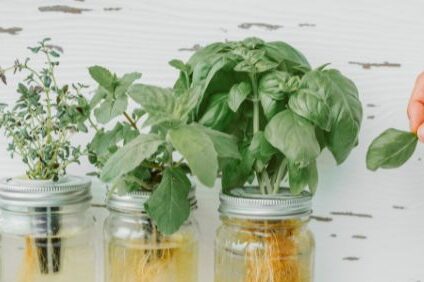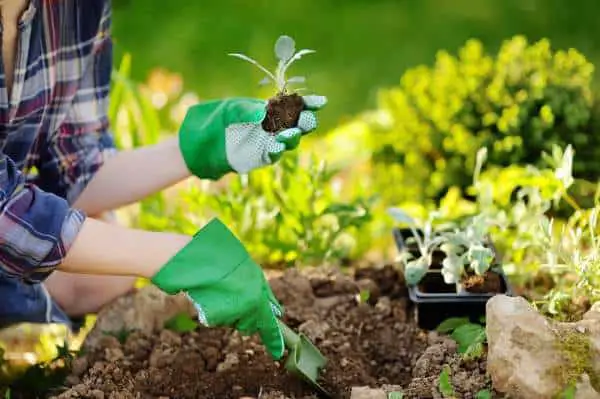By exploring the world of hydroponic basil, you can enjoy this fresh herb all year round and optimize its growth conditions for maximum yield and flavor.
We will cover everything from selecting the best hydroponic systems and grow lights for your hydroponic basil plants to choosing the ideal variety that thrives in a hydroponic environment.
We offer valuable tips on harvesting while ensuring it remains healthy for future harvests. With our expert guidance, you’ll soon become an accomplished hydroponic grower with enough basil to make batches of pesto!

Why Grow Basil Hydroponically?
This popular herb is not only easy to grow but also offers numerous benefits when grown hydroponically.
You will enjoy faster growth in a well-maintained hydroponic system than if they were grown in soil. It also requires less space using hydroponic growing methods.
Some say hydroponically grown basil has better flavor and aroma and is more intense than basil grown in traditional soil-based methods.
Also, by growing your basil indoors using a controlled environment, you’ll minimize the risk of pests and diseases affecting your plants.
What You Need
To grow hydroponic basil successfully, you’ll need a few essential items to set up your system and ensure the healthy growth of your plants.
The initial step is to select a hydroponic system. These include Deep Water Culture (DWC), Nutrient Film Technique (NFT), The Kratky Method, and Mason Jar systems.
Basil requires ample light to thrive. Invest in grow lights – either an LED grow light or fluorescent bulbs specifically designed for plant growth.
You start growing hydroponic basil from either seeds or cuttings. Choose a growing medium that provides good drainage and aeration for your basil plants. Some popular options include Coco Coir, Rockwool, or Perlite.
A well-balanced nutrient solution is crucial for your basil plants to grow strong and healthy. Look for a formula specifically designed for hydroponic systems. Maintaining the proper pH balance of your nutrient solution is critical. Invest in a reliable pH meter.
The Best Hydroponic Systems for Growing Basil
Several hydroponic systems work well for growing basil. Each system has its advantages and disadvantages.
Deep Water Culture, or DWC, is a simple yet effective method of growing hydroponically. In this system, the plant roots are submerged in nutrient-rich water while an air pump provides oxygen to prevent root rot.
In the Nutrient Film Technique (NFT) system, a thin film of nutrient solution continuously flows over the plant roots as they sit on a sloping surface like PVC pipes or channels.
The Kratky Method is a passive hydroponic system that requires no electricity or water pumps. Instead, the plant roots are suspended in nutrient-rich water with an air gap above the solution to allow for oxygen absorption. As the plants grow and consume nutrients, the water level drops, providing more space for root growth and oxygen access.
The Mason Jar method is another simple yet effective way to grow hydroponic basil at home. In this setup, you suspend a net pot containing your basil seedling into a mason jar filled with nutrient solution. This is considered a variation of Kratky’s non-circulating hydroponics system but on a smaller scale.
The Best Grow Lights for Your Hydroponic Basil
When selecting a grow light for hydroponic basil, there are various types to choose from, each with its benefits and drawbacks.
Fluorescent lights are a popular choice among hydroponic growers due to their energy efficiency and relatively low heat output. They’re economical and can be obtained at many DIY outlets.
LED grow lights have become increasingly popular in recent years. LED panels are efficient and generate little heat, making them ideal for small-scale indoor gardens or spaces where temperature regulation is essential.
There are other options available but are preferred by commercial growers.
The Best Basil Varieties for Growing Hydroponically
Several different varieties of basil thrive in hydroponic systems, and they can be categorized into fast-growing, slow-growing, and specialty varieties.
Some fast-growing varieties include Genovese basil (the most commonly used), Lettuce Leaf Basil, and Greek Columnar Basil. Some of the slow-growing varieties of basil include Purple Basil and Thai Basil.
There are also some specialty varieties to consider in your basil growing system that include Lemon Basil and Holy Basil (Tulsi).
Set Up Your Hydroponic System
Growing hydroponic basil requires a suitable system to provide the necessary nutrients, water, and support for your plants. There are several popular systems that you can choose from depending on your preferences and available resources: Deep Water Culture, Nutrient Film Technique, and The Kratky Method.
A growing medium is indispensable in any hydroponic system, providing a stable base for the roots while permitting them to access oxygen and nutrients.
There are several to choose from: Coco Coir, Rockwool, Perlite/Vermiculite Mix, and Oasis Cubes.
Getting Started Growing
There are two primary methods to start growing hydroponic basil: from cuttings and seeds. Both methods present their benefits, so let’s look into each one.
Growing hydroponic basil from cuttings is a quick way to get your plants started. You can obtain the cuttings either by purchasing them or taking them from an existing basil plant you already have.
Cut a healthy stem with at least three sets of basil leaves on it. Remove the lower set of leaves, leaving only the top two sets intact. Place the cutting into a container filled with water. Change the water every few days and wait for roots to develop.
Once roots appear, transfer your cutting into your hydroponic system following its specific setup instructions.
If you prefer starting with basil seeds, soak the seeds in water for a few hours. Place the soaked seeds into your chosen grow medium and keep them moist by spraying them with water daily. Put the seeds in a warm, well-lit place.
Once basil seedlings have developed their first set of fresh basil leaves, transfer them into your hydroponic system.
Having an understanding of the fundamentals of tending to plants and how basil grows is necessary for successfully cultivating hydroponic basil.
Care and Maintenance
Growing hydroponic basil requires consistent care and maintenance for good plant health.
As indicated previously, proper lighting is crucial for growing healthy hydroponic basil. 10-12 hours of light should be provided daily to the hydroponic basil. You can use grow lights to supplement natural sunlight.
Basil does best in temperatures between 65°F – 85°F, so be sure to use a thermometer for monitoring the ambient temperature around your system regularly. If needed, consider using heating mats or greenhouse heaters to maintain the ideal temperature.
Providing your hydroponic basil with the right nutrients is essential for healthy growth. A well-balanced hydroponic nutrient solution should contain all necessary macro and micronutrients.
These include nitrogen (N), phosphorus (P), potassium (K), calcium (Ca), magnesium (Mg), and sulfur (S) as well as trace elements like iron, manganese, zinc, copper, boron, molybdenum, and chlorine.
You can find pre-mixed hydroponic solutions at gardening stores or online retailers. Be sure to follow the manufacturer’s instructions regarding mixing ratios and frequency of application. Regularly monitor pH levels within your system using a pH meter – the optimal pH range for basil is between 5.5 -6.5.
Harvest Your Hydroponic Basil
To maximize yield and maintain the health of your hydroponic basil, proper harvesting techniques should be employed.
The best time to harvest your basil is when the plant reaches 6-8 inches in height or has at least six sets of leaves. This usually occurs within 4-6 weeks after planting.
Select healthy stems with plenty of leaves on them. Take your cuttings above a leaf node, as this encourages new growth and prevents damage to the main stem. Make sure not to take too much at once! You need at least two-thirds of the plant left so it has enough energy for regrowth.
And whatever you cut, make sure to rinse the leaves thoroughly under cold water before using it. Properly cleaning produce is essential for food safety.
Tips for Keeping Hydroponic Basil Alive
By following these tips, you can guarantee a vigorous and productive plant that will provide fresh basil regularly.
Maintaining the right water quality is essential for the growth of your basil. Oxygenation is also important as it promotes root health and prevents diseases. Use an air pump with air stones to maintain proper oxygen levels in your nutrient solution.
Rinse and clean your system regularly. This includes your grow medium, the reservoirs for your nutrients, and sterilizing all of your equipment.
Regular pruning is essential for maintaining healthy and bushy basil plants. Pinch off the growing tips, removing any yellowing or dead leaves as well. This encourages lateral growth and prevents overcrowding in your hydroponic system.
Keep watch for typical bugs such as aphids, whiteflies, and spider mites. Implement integrated pest management strategies, such as using beneficial insects or organic pesticides if necessary.
Basil thrives in specific environmental conditions; therefore, it’s crucial to maintain temperature, humidity, and air circulation consistently.
Conclusion
Hydroponic basil is a great way to grow fresh, flavorful herbs year-round. With the right equipment and care, you can easily set up your hydroponic system and enjoy an endless supply of basil.
If you’re interested in starting your hydroponic garden or want more information on how to keep your plants healthy and thriving, reach out to us! Our knowledgeable team is here to answer any queries you have about hydroponics and offer assistance in getting started.





